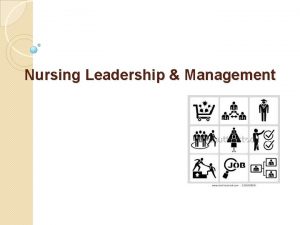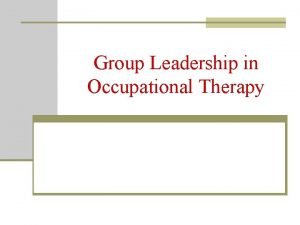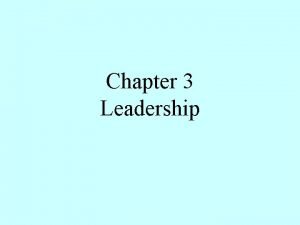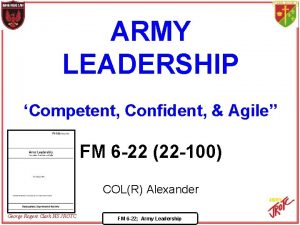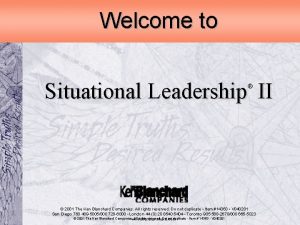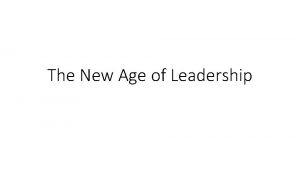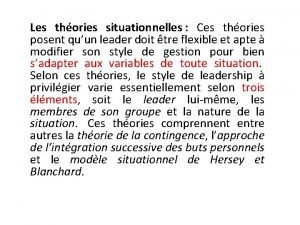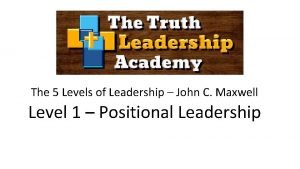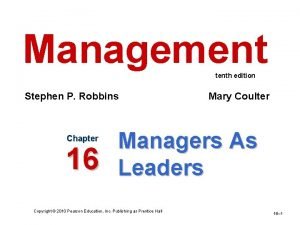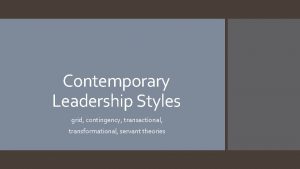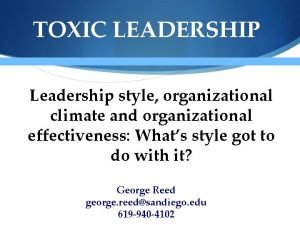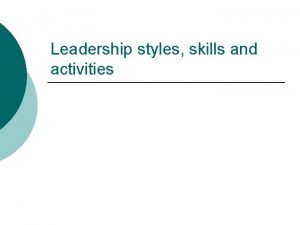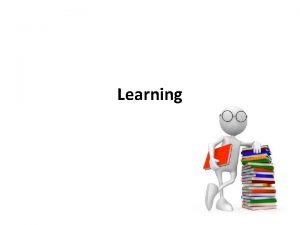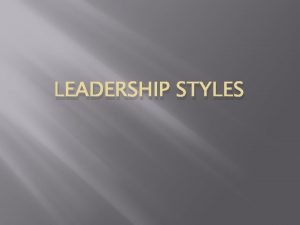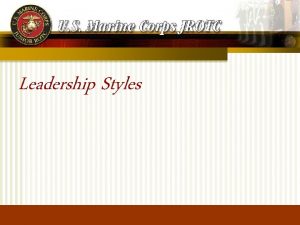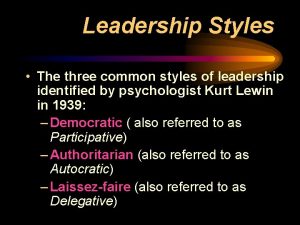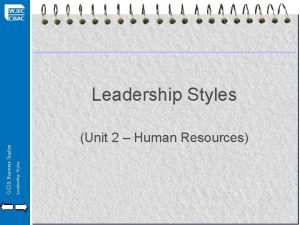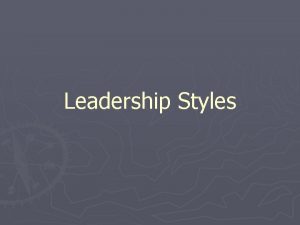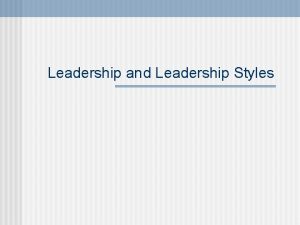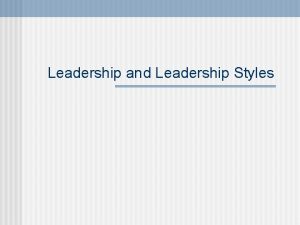Leadership for Safety Leadership Styles TM Leadership and



















- Slides: 19

Leadership for Safety: Leadership Styles TM Leadership and Management GSR part 2 – application of core concepts

I What is Leadership? What does this sentence mean ? “Leadership development of our leadership is expected to lead to strengthening our business leadership” LEADERSHIP IS USED IN MANY MEANINGS WHICH SOMETIMES CAUSES CONFUSION 2

Many Definitions of Leadership • “Leadership is the art to of influencing and directing people in such a way that will win their obedience, confidence, respect and loyal cooperation in achieving common objectives. ” — U. S. Air Force • “The first job of a leader is to define a vision for the organization…. Leadership of the capacity to translate vision into reality. ” — • Warren Bennis, President, University of Cincinnati, University of Maryland symposium, January 21, 1988

Definitions of Leadership • “The superior leader gets things done with very little motion. He imparts instruction not through many words but through a few deeds. He keeps informed about everything but interferes hardly at all. He is a catalyst, and though things would not get done well if he weren’t there, when they succeed he takes no credit. And because he takes no credit, credit never leaves him. “ — • Lao Tse, Tao Te Ching • “Leadership occurs when one person induces others to work toward some predetermined objectives. ” — • Massie • “Leadership is the ability of a superior to influence the behavior of a subordinate or group and persuade them to follow a particular course of action. ” — • Chester Bernard

Leadership in GSR-2 • ‘Leadership’ is the use of an individual’s capabilities and competences to give direction to individuals and groups and to influence their commitment to achieving the fundamental safety objective and to applying the fundamental safety principles, by means of shared goals, values and behaviour.

Leadership and Management • So what is the difference between leadership and management?

What does Leadership mean in the IAEA literature? • Management is a formal, authorized function for ensuring that an organization operates efficiently and that work is completed in accordance with requirements, plans and resources. Leadership is the use of an individual’s capabilities and competences to give direction to and to influence the commitment of individuals – GSR Part 2 8

Leadership versus Management • Edgar Schein is probably the best known author on organizational culture • “What distinguishes leadership from management … is that leaders create and change culture, while managers … act within it. ” • Edgar H. Schein, Organizational Culture and Leadership, (2008) Leaders see new and better ways of doing things and change the system. Managers work within the system. Art versus paint-by-number

So Why would we Want to Follow a Leader? • “Those who lead, inspire us. Whether they are individuals or organizations. We follow those who lead, not because we have to, but because we want to. We follow those who lead, not for them, but for ourselves. ” • Simon Sinek • ‘How great leaders inspire action’ https: //www. youtube. com/watch? v=qp 0 HIF 3 Sf. I 4

So Why Type of Person would we Want to Follow? • There a lot of models out there

Desirable and non-desirable Leadership Traits* • • • Positive • Confidence builder • Foresight • Intelligent • Win-win problem solver • Administrative skills • Excellence oriented • Just • Plans ahead • Dynamic • Trustworthy • Loner Motivational Decisive • Irritable Communicative • Ruthless Coordinator Honest • Asocial Encouraging • Non-explicit Motive arouser Dependable • Dictatorial Effective bargainer • Non-cooperative Informed Team builder • Egocentric * 14

Mechanisms of leading – How to influence positively people? People pay attention to how their leaders behave themselves “Everybody” “Good vibes” “Just do what I tell and not what I do” does not really pay off in the long run Also who does what (e. g. makes the decisions in reality) is important “Example” “Wise” 15

Leadership competencies Another look at competences: Competency wheel, adapted from Chandler: “Marks of a leader” (2001) Observe: the example is not necessarily optimized for emergencies

Leadership styles Authoritarian/Autocratic leader Sub-class – Paternalistic/Maternalistic - Unilateral command-control, position based, often atmosphere of some sort of fear (paternalistic is the benevolent version), sycophants Democratic/participative - Generally leads to job satisfaction, not necessarily in all cultures/situations Laissez-faire (let them do…) - Expert / distributed organizations, Regular feedback necessary, Indifferent bureaucrat leader(? !) Transactional - Goals, rewards, sanctions – “Manager leader” Transformational leader - Inspires people … true leader(? !) 17

What Good Leaders do? But what is on the other side? In decision making and leadership you never have the full information or a crystal ball … and you are dealing with people 18

Leadership competencies • Situational awareness – form a picture based on often conflicting and hazy information from scattered sources • Self-awareness. This competency involves being aware of one’s own behaviour, particularly with regard to how that behaviour influences the behaviour of others. • Relationship building. Communication and relationship building often go together and are keys to good leadership – creates the climate • Practical capability. Having the necessary nuclear knowledge, as well as the relevant behavioural and management ability, is important • Decision making capability & strategic view. The ability to make decisions in difficult situations and present relevant goals. • Team management and coordination with other actors – this is where your leadership, decision making and communication skills are tested • Authenticity, consistency and integrity of leader behaviours and actions are critical elements to promote credibility and inspire trust among those that they are leading. • Stress management. Emergencies differ from exercises, and some cope with the stress better and then others

Emergency leadership • The fact that you experience a nuclear emergency often means something seriously did not go according to the script • The weaknesses of you / team / organization will exacerbated in such situations • The roles in emergencies may be different and have very different requirements as your day to day ones • Getting trustworthy information and being able to distribute it may be a challenge • Finally, these are the very “darkest hour” situations where leadership will be vital Practice improves response And this includes Leadership


Questions ? Thank you! 23
 Nursing leadership theories
Nursing leadership theories Daniel goleman leadership styles
Daniel goleman leadership styles Leadership styles business a level
Leadership styles business a level Kurt lewin leadership styles
Kurt lewin leadership styles Leadership speech
Leadership speech Army attributes and competencies
Army attributes and competencies The ken blanchard companies situational leadership ii
The ken blanchard companies situational leadership ii Goleman leadership styles
Goleman leadership styles New age leadership styles
New age leadership styles Pedagogical leadership in early childhood
Pedagogical leadership in early childhood North south east west leadership styles
North south east west leadership styles Leadership situationnel de hersey et blanchard
Leadership situationnel de hersey et blanchard Toastmasters leadership styles
Toastmasters leadership styles John maxwell leadership styles
John maxwell leadership styles Kepemimpinan iowa
Kepemimpinan iowa Kurt lewin leadership styles
Kurt lewin leadership styles Kurt lewin leadership styles
Kurt lewin leadership styles Servant leader vs contingency plan
Servant leader vs contingency plan Connective leadership styles
Connective leadership styles Toxic leadership styles
Toxic leadership styles
